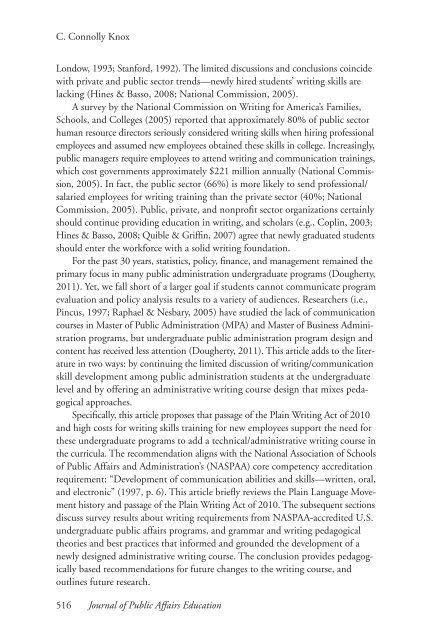Teaching Grammar and Editing in Public Administration ... - Naspaa
Teaching Grammar and Editing in Public Administration ... - Naspaa
Teaching Grammar and Editing in Public Administration ... - Naspaa
Create successful ePaper yourself
Turn your PDF publications into a flip-book with our unique Google optimized e-Paper software.
C. Connolly Knox<br />
Londow, 1993; Stanford, 1992). The limited discussions <strong>and</strong> conclusions co<strong>in</strong>cide<br />
with private <strong>and</strong> public sector trends—newly hired students’ writ<strong>in</strong>g skills are<br />
lack<strong>in</strong>g (H<strong>in</strong>es & Basso, 2008; National Commission, 2005).<br />
A survey by the National Commission on Writ<strong>in</strong>g for America’s Families,<br />
Schools, <strong>and</strong> Colleges (2005) reported that approximately 80% of public sector<br />
human resource directors seriously considered writ<strong>in</strong>g skills when hir<strong>in</strong>g professional<br />
employees <strong>and</strong> assumed new employees obta<strong>in</strong>ed these skills <strong>in</strong> college. Increas<strong>in</strong>gly,<br />
public managers require employees to attend writ<strong>in</strong>g <strong>and</strong> communication tra<strong>in</strong><strong>in</strong>gs,<br />
which cost governments approximately $221 million annually (National Commission,<br />
2005). In fact, the public sector (66%) is more likely to send professional/<br />
salaried employees for writ<strong>in</strong>g tra<strong>in</strong><strong>in</strong>g than the private sector (40%; National<br />
Commission, 2005). <strong>Public</strong>, private, <strong>and</strong> nonprofit sector organizations certa<strong>in</strong>ly<br />
should cont<strong>in</strong>ue provid<strong>in</strong>g education <strong>in</strong> writ<strong>in</strong>g, <strong>and</strong> scholars (e.g., Copl<strong>in</strong>, 2003;<br />
H<strong>in</strong>es & Basso, 2008; Quible & Griff<strong>in</strong>, 2007) agree that newly graduated students<br />
should enter the workforce with a solid writ<strong>in</strong>g foundation.<br />
For the past 30 years, statistics, policy, f<strong>in</strong>ance, <strong>and</strong> management rema<strong>in</strong>ed the<br />
primary focus <strong>in</strong> many public adm<strong>in</strong>istration undergraduate programs (Dougherty,<br />
2011). Yet, we fall short of a larger goal if students cannot communicate program<br />
evaluation <strong>and</strong> policy analysis results to a variety of audiences. Researchers (i.e.,<br />
P<strong>in</strong>cus, 1997; Raphael & Nesbary, 2005) have studied the lack of communication<br />
courses <strong>in</strong> Master of <strong>Public</strong> Adm<strong>in</strong>istration (MPA) <strong>and</strong> Master of Bus<strong>in</strong>ess Adm<strong>in</strong>istration<br />
programs, but undergraduate public adm<strong>in</strong>istration program design <strong>and</strong><br />
content has received less attention (Dougherty, 2011). This article adds to the literature<br />
<strong>in</strong> two ways: by cont<strong>in</strong>u<strong>in</strong>g the limited discussion of writ<strong>in</strong>g/communication<br />
skill development among public adm<strong>in</strong>istration students at the undergraduate<br />
level <strong>and</strong> by offer<strong>in</strong>g an adm<strong>in</strong>istrative writ<strong>in</strong>g course design that mixes pedagogical<br />
approaches.<br />
Specifically, this article proposes that passage of the Pla<strong>in</strong> Writ<strong>in</strong>g Act of 2010<br />
<strong>and</strong> high costs for writ<strong>in</strong>g skills tra<strong>in</strong><strong>in</strong>g for new employees support the need for<br />
these undergraduate programs to add a technical/adm<strong>in</strong>istrative writ<strong>in</strong>g course <strong>in</strong><br />
the curricula. The recommendation aligns with the National Association of Schools<br />
of <strong>Public</strong> Affairs <strong>and</strong> Adm<strong>in</strong>istration’s (NASPAA) core competency accreditation<br />
requirement: “Development of communication abilities <strong>and</strong> skills—written, oral,<br />
<strong>and</strong> electronic” (1997, p. 6). This article briefly reviews the Pla<strong>in</strong> Language Movement<br />
history <strong>and</strong> passage of the Pla<strong>in</strong> Writ<strong>in</strong>g Act of 2010. The subsequent sections<br />
discuss survey results about writ<strong>in</strong>g requirements from NASPAA-accredited U.S.<br />
undergraduate public affairs programs, <strong>and</strong> grammar <strong>and</strong> writ<strong>in</strong>g pedagogical<br />
theories <strong>and</strong> best practices that <strong>in</strong>formed <strong>and</strong> grounded the development of a<br />
newly designed adm<strong>in</strong>istrative writ<strong>in</strong>g course. The conclusion provides pedagogically<br />
based recommendations for future changes to the writ<strong>in</strong>g course, <strong>and</strong><br />
outl<strong>in</strong>es future research.<br />
516 Journal of <strong>Public</strong> Affairs Education
















